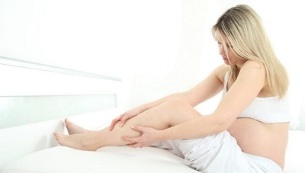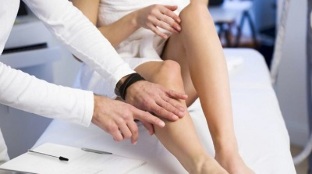Varicose veins are called diseases that quickly become chronic. The disease causes a change in the length and diameter of the veins, the appearance of nodules, thinning of the venous walls. Varicose veins often manifest during pregnancy, when a woman's body has significant loads in the background of hormonal changes.
Reasons to look

If we consider the reasons under which varicose veins occur during pregnancy, we can distinguish several main ones:
- Weight change.During pregnancy, veins appear on the legs due to an increase in weight of ten or more kilograms, which leads to an increase in pressure and load on the vessels;
- Hormonal changes in the body.During the formation of the fetus, a woman's hormonal base is renewed several times, which injures the vessels - they lose elasticity, become brittle, prone to varicose veins;
During pregnancy, veins appear on the legs due to weight gain of ten or more pounds.
- During pregnancy, the function of the venous valves changes as the amount of circulating blood increases. It should be noted that varicose veins do not disappear anywhere after pregnancy, if left untreated;
- Hereditary factors. If one of the parents of a pregnant woman has varicose veins, the chances of manifesting the same disease are high;
- Selecting the wrong clothes and shoes. Sometimes expectant mothers are surprised where varicose veins come from, without thinking that tight clothes and high-heeled shoes can cause it;
- Decreased physical activity. Blood stagnation in the veins of the legs during pregnancy can begin if the pregnant woman moves a little and does not do special exercises.
Some of the causes that cause varicose veins during pregnancy are easy to remove - just change your habits.
Symptoms and signs
Varicose veins during pregnancy in the early stages are difficult to detect because there are no pronounced symptoms.

However, it is worth contacting your doctor if the following symptoms are present:
- feeling of heaviness and pain in legs;
- edema, especially in the evening if you sit for a long time;
- convulsions, especially at night;
- redness or darkening of the skin;
- appearance of vascular networks;
- seals on the skin, the appearance of trophic ulcers;
- Inflamed veins in pregnancy can be easily felt.
Types of varicose veins during pregnancy
Varicose veins during pregnancy can be of several types. The most common disease is:
- in the groin;
- on legs;
- in the vagina;
- in utero.
The manifestation of varicose veins in the small pelvis has symptoms similar to some gynecological diseases, so it is the most difficult to diagnose. With each pregnancy, the risk of varicose veins on the lips increases (symptoms are most felt after physical exertion or intercourse).
Diagnostics
Varicose veins and pregnancy have a great impact on the female body, causing additional stress to many organs, so it is important to recognize the disease at an early stage.
Duplex sonography is used today to identify varicose veins in pregnant women. This modern type of diagnostics has replaced previously performed ultrasound angioscanning and Doppler mapping. Duplex sonography is performed within twenty minutes and provides detailed information on the condition of deep and superficial veins.
In some cases, for additional diagnostics, run:
- Segmental Doppler.A simple but reliable test that shows the condition of the arteries, determining their patency and narrowing.
- BMR (magnetic resonance venography).If varicose veins are diagnosed during pregnancy, this examination allows you to assess the condition of blood vessels without the use of contrast, it does not cause any harm to the body.
- Computed tomography phlebography.Derived by contrast, it allows you to assess the condition of blood vessels at great depths. If varicose veins have vague symptoms, this type of examination is prescribed.

Disease treatment methods
Not all methods that can be used to treat varicose veins after pregnancy during pregnancy can be used. For example, injections of certain drugs cannot be used during pregnancy, and surgery is not always possible. These restrictions also apply to women with varicose veins on their legs but who plan to become pregnant in the next two years.Surgical treatment
As mentioned earlier, varicose veins during pregnancy are dangerous due to limitations in treatment options. However, there are situations when drug treatment is not enough, then surgery is performed. For example, if severe thrombophlebitis is expressed or if there are trophic ulcers that do not heal.
In most cases, surgeries are performed at a gestational age of no more than six months, using sclerotherapy or frequency ablation, and further surgeries are performed after pregnancy. In the postoperative period, it is prescribed to wear special underwear and therapeutic exercises - these recommendations refer to the postpartum period.
Today, if a severe varicose vein is detected during pregnancy, the use of a laser instead of a scalpel is practiced in treatment. Modern technique allows you to quickly and safely overcome varicose veins.
Medications
Doctors know perfectly well what the danger of varicose veins is, so they recommend contacting a specialist at the first manifestations of the disease. In such a situation, a course of venotonic drugs and means for normalizing blood density is prescribed. There is also a large selection of special ointments and gels for external use, including those that contain ginkgo biloba. All medications that affect venous tone are serious, so they should only be taken according to the regimen recommended by your doctor.
Alternative treatment
People have long been involved in the tandem of "pregnancy and varicose veins", so earlier, and even today, folk methods such as lotions, tinctures, ointments, baths are widely used in treatment. Of course, if the disease is neglected, then these techniques are considered exclusively adjuvant therapy, but in the early stages alternative treatment is quite effective.Tincture compressions:

- Hop tincture helps to overcome varicose veins during pregnancy in the initial stages. You need to take 1 tablespoon of the bump, pour 200 milliliters of boiling water and hold for 20 minutes. After that, the solution is filtered and used for coatings. Infusions of wild chestnut flowers or leaves are prepared in a similar way. Such compresses can be put on at night and kept on the foot until morning.
- Veins during pregnancy are treated with powder of peeled chestnut fruit: 50 grams of this powder is poured with 200 milliliters of vegetable oil and the resulting composition massages the feet, before bedtime;
- If early varicose veins are detected during pregnancy, scalded cabbage leaves are used for dressings that relieve inflammation, pain, swelling.
Varicose veins during pregnancy on the legs are recommended to be treated with trays of infusions of various medicinal plants, the choice of which is wide enough in every pharmacy. Recommended for this:
- do not exceed the temperature of the solution in the bath over 38 degrees;
- bathe for no longer than 15 minutes;
- after the procedure, do a relaxing massage;
- lie at the end of the bath for 30-40 minutes with your legs raised.
Varicose veins in pregnant women are also treated with herbal decoctions taken orally:
- A decoction of meadow clover flower is prepared: 1 tablespoon of chopped flowers is poured into a thermos and poured with 400 milliliters of boiling water. After two hours, filter the broth and take ½ glasses 4 times a day;
- You can make a collection from undercut leaves, wild strawberries and cranberries, lemon balm, as well as marigold and viburnum flowers. The ingredients are mixed in equal parts, 2 tablespoons of the resulting mixture is poured with 400 milliliters of boiling water and kept for 15 minutes in a water bath. After that, you need to keep the collection in a warm place for 40 minutes. Take ½ cups 4 times a day.
Disease Prevention
Varicose veins in the legs, like any disease, not only need to be treated, but preventive measures must be taken to prevent or avoid recurrence:
- Long sitting or standing is not recommended. It is advisable to rest on your side to relieve the stress on the veins in your legs and small pelvis.
- To relieve stress on the veins in your legs, keep your legs raised while lying down or sitting.
- To lighten the veins on your legs during pregnancy, wear special compression stockings. Such underwear helps in the distribution of blood through the veins, stimulates the blood in the veins of the legs and reduces the probability of blood clots. Compression knitwear is recommended to be worn not only during, but also after pregnancy, for one and a half to two months.
Remember that varicose veins on the legs are less common in people who exercise and lead a healthy lifestyle. Even light exercise helps maintain fitness and reduces the risk of developing varicose veins.




































